Control of voltage compensation to enhance ride - Through of dfig wind turbine during symmetrical and asymmetrical grid faults
A doubly fed induction generator (DFIG) is a common subsystem for large variable speed
wind turbines that are connected to a and wherein, the stator windings are directly connected
to the point of common coupling (PCC) via a transmission transformer. The rotor windings
are controlled by a back-to-back converter that serves as a power interface between the rotor
windings and the PCC. The power rating of the back-to-back converter mainly depends on the
speed operation range of the DFIG, typically designed as 30% of nominal rating of the wind
turbine. Thus, severe voltage sags and the resulting stator flux place a significant electrical
stress on the machine-side converter and thereby increase mechanical stress on the gearbox as
well [1, 2].
During deep balanced voltage sags, high per-unit currents and shaft torque pulsations are
known to appear in the standard DFIG wind turbine architecture [3, 4]. In the literature, several
solutions have been proposed to improve ride-through capability of DFIG [5-11]. A series
braking resistance applied to the stator windings during a voltage sag has been shown to be
able to reduce torque and current spikes in the DFIG [5]. Either a silicon controlled rectifier
rotor crowbar circuit or a three-phase rectifier and adjustable resistive load have been
introduced to improve the rotor circuit, from which have demonstrated enhancement in the
DFIG ride-through capability [6-9]. However, as penetration of wind power into electric grid
gets larger, much more stringent grid codes are being set up [12]. According to the recent
regulations, wind turbines are not only required to stay connected to ride through the grid
faults, but also are required to inject reactive current for assisting the grid to recover to its rated
voltage. The braking resistor and the crowbar technology do not fulfill the grid codes, as the
turbine cannot supply reactive power during the duration of the activation of the braking
resistor or the crowbar. In order to satisfy the grid codes, static synchronous compensator
(STATCOM) and dynamic voltage restorer (DVR) to enhance the ride-through capability of
wind turbines or wind farms [13-15]. STATCOM is connected in parallel to the line, referred
as shunt voltage compensation while DVR is connected in series with the line via the
transformer, referred as series voltage compensation. However, STATCOM is still challenging
to cope with severe voltage fault since it is based on shunt compensation. Compared with a
parallel reactive power/voltage compensator, a series compensator would be much more
effective in restoring voltage in strong grid utility, if steps are taken to minimize the power
capacity of the devices.
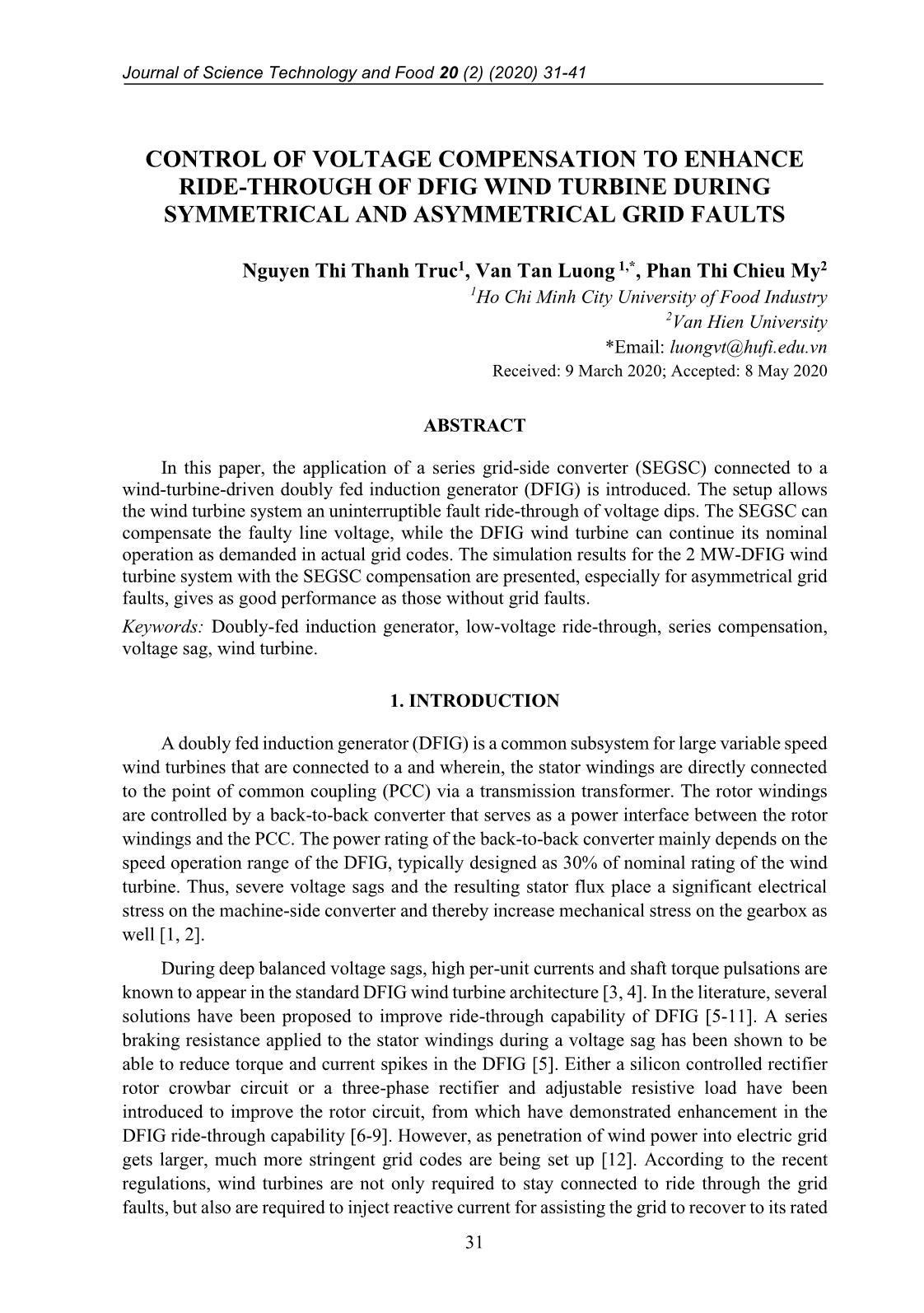
Trang 1
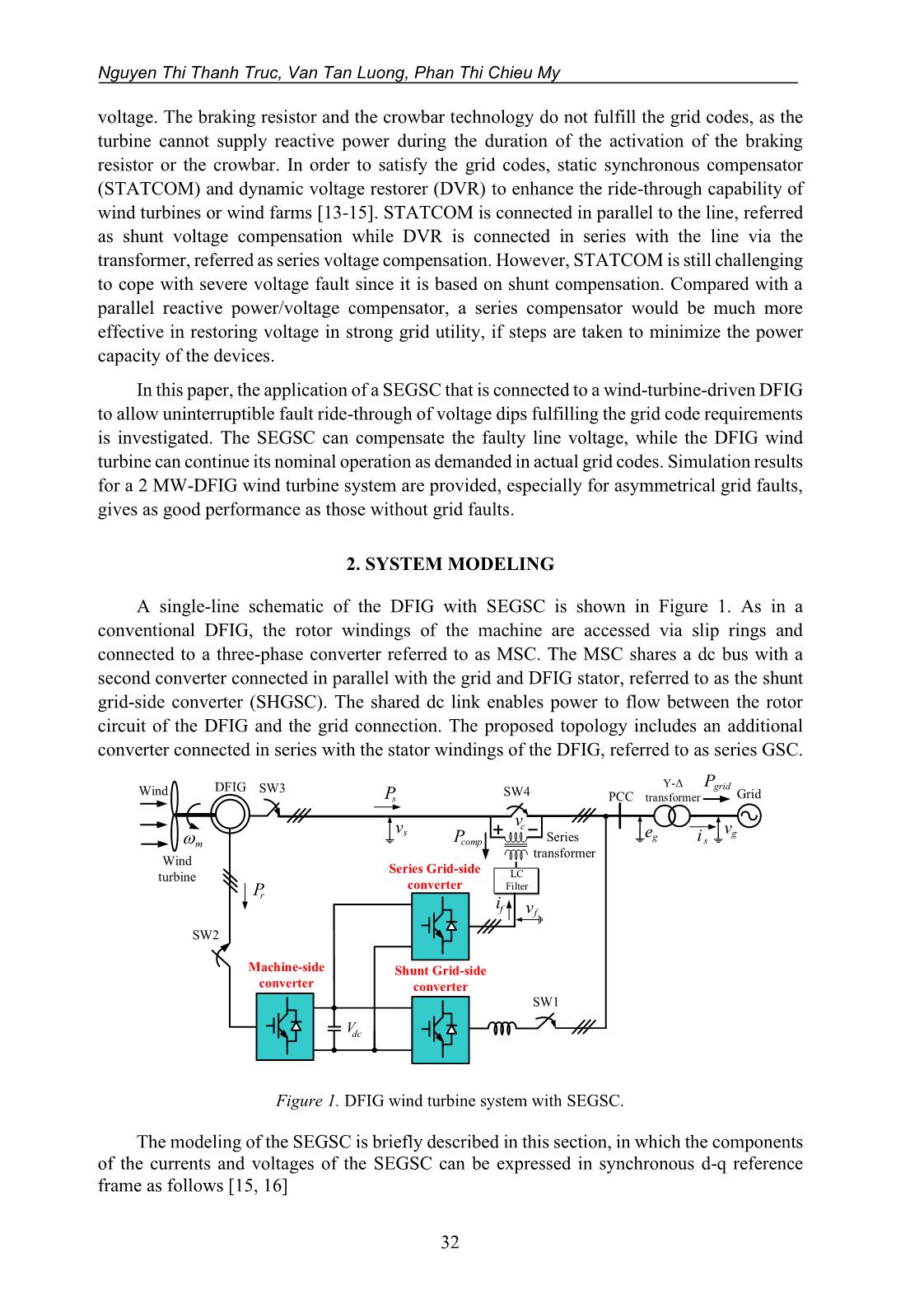
Trang 2
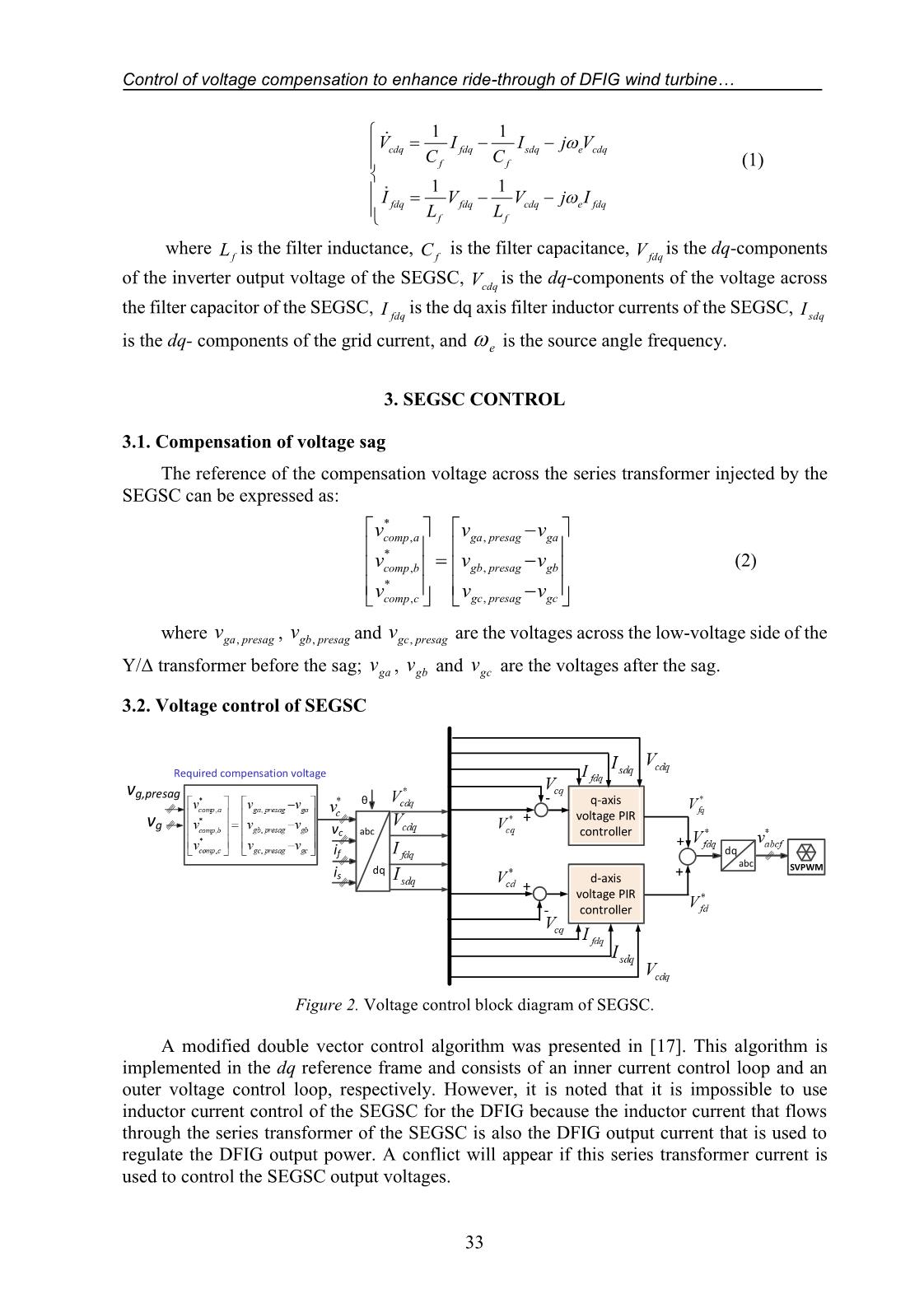
Trang 3
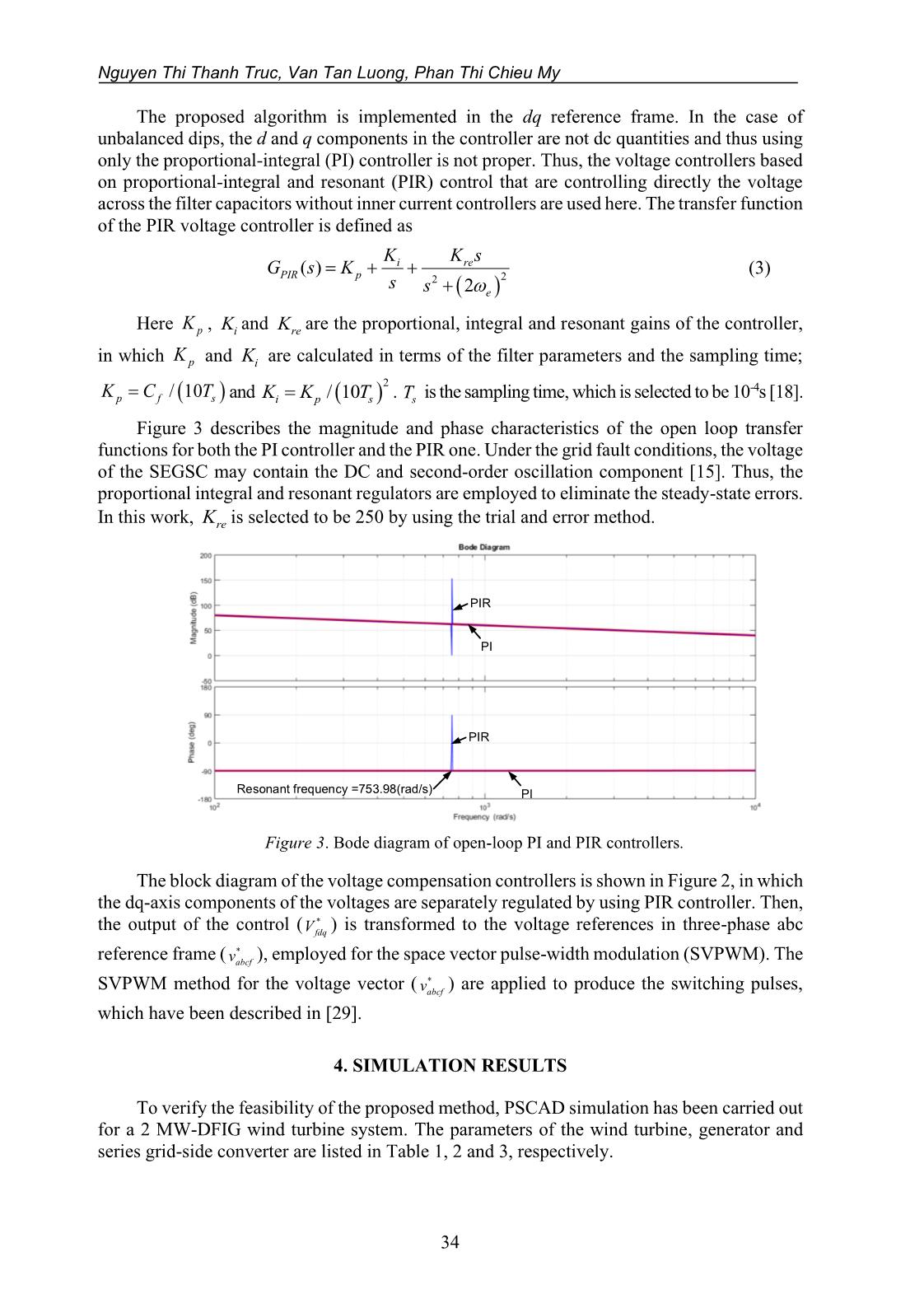
Trang 4
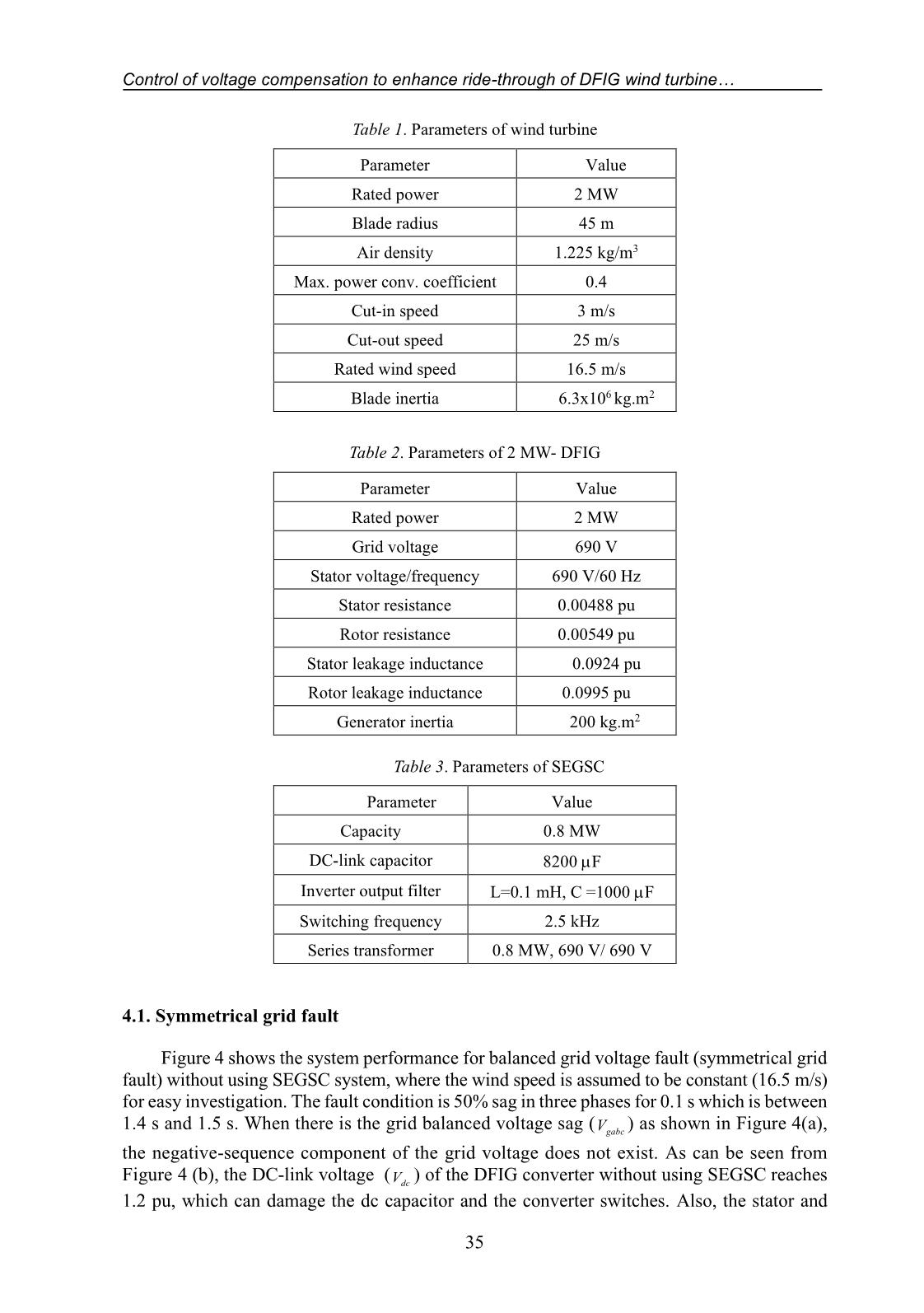
Trang 5
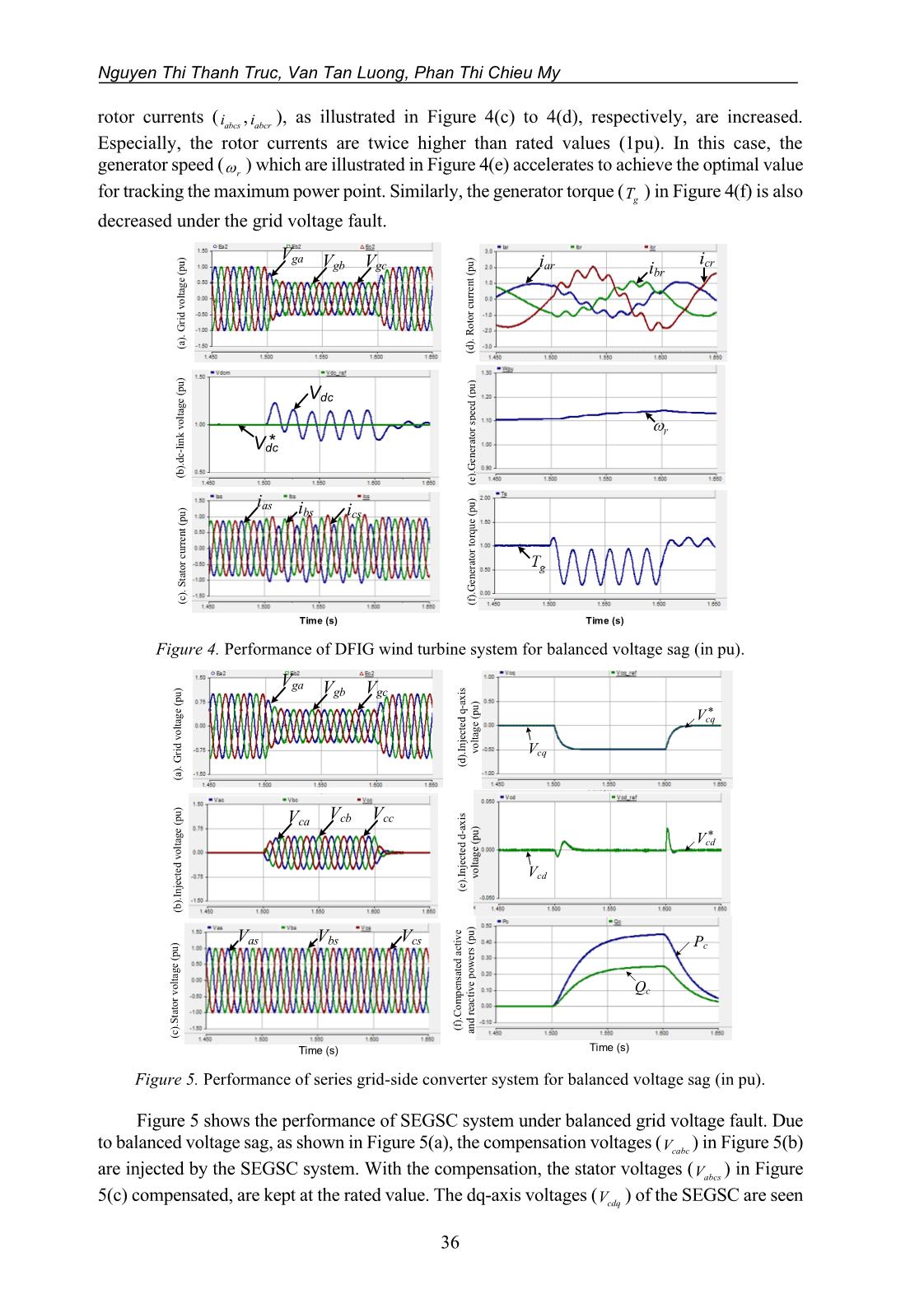
Trang 6
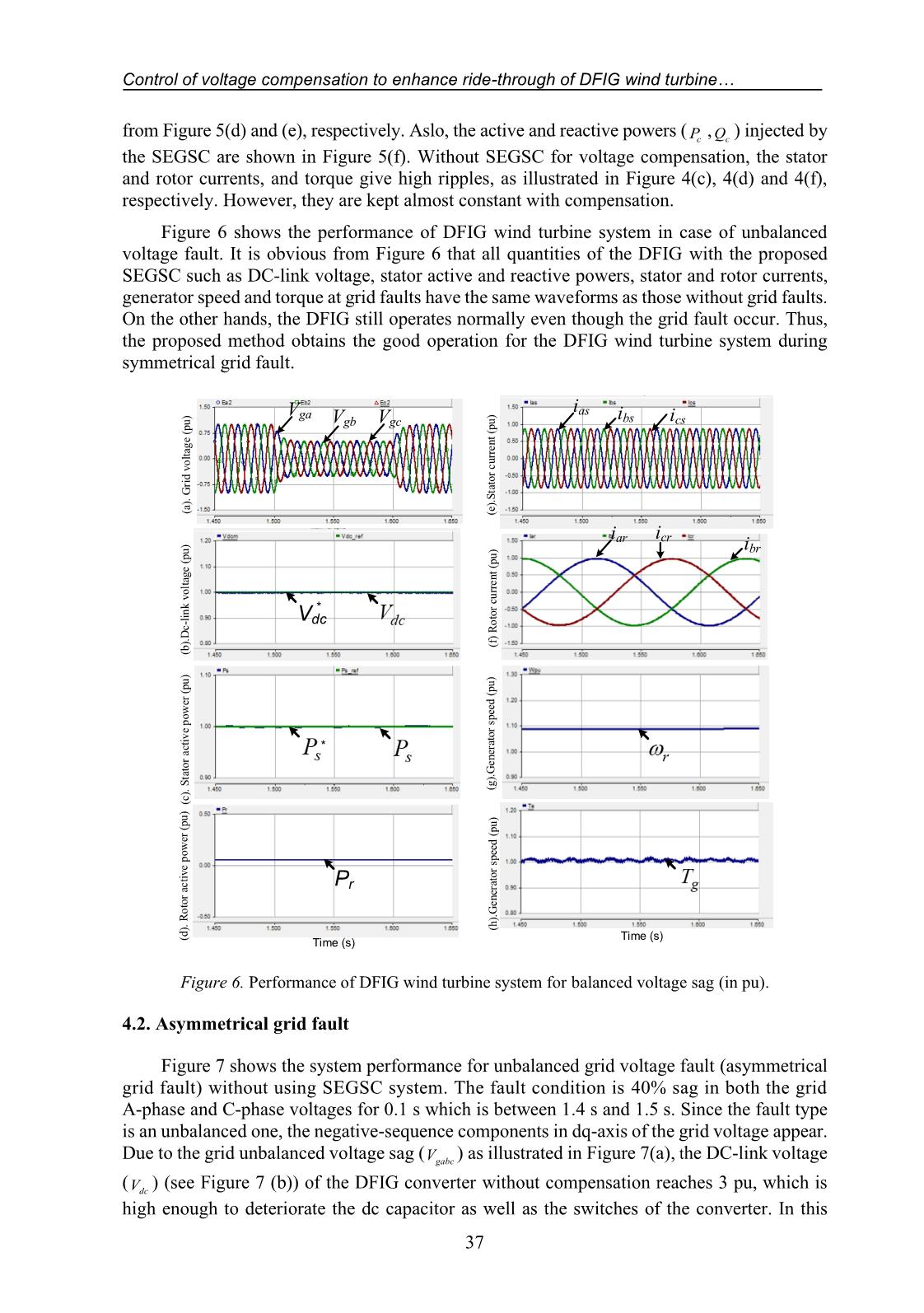
Trang 7
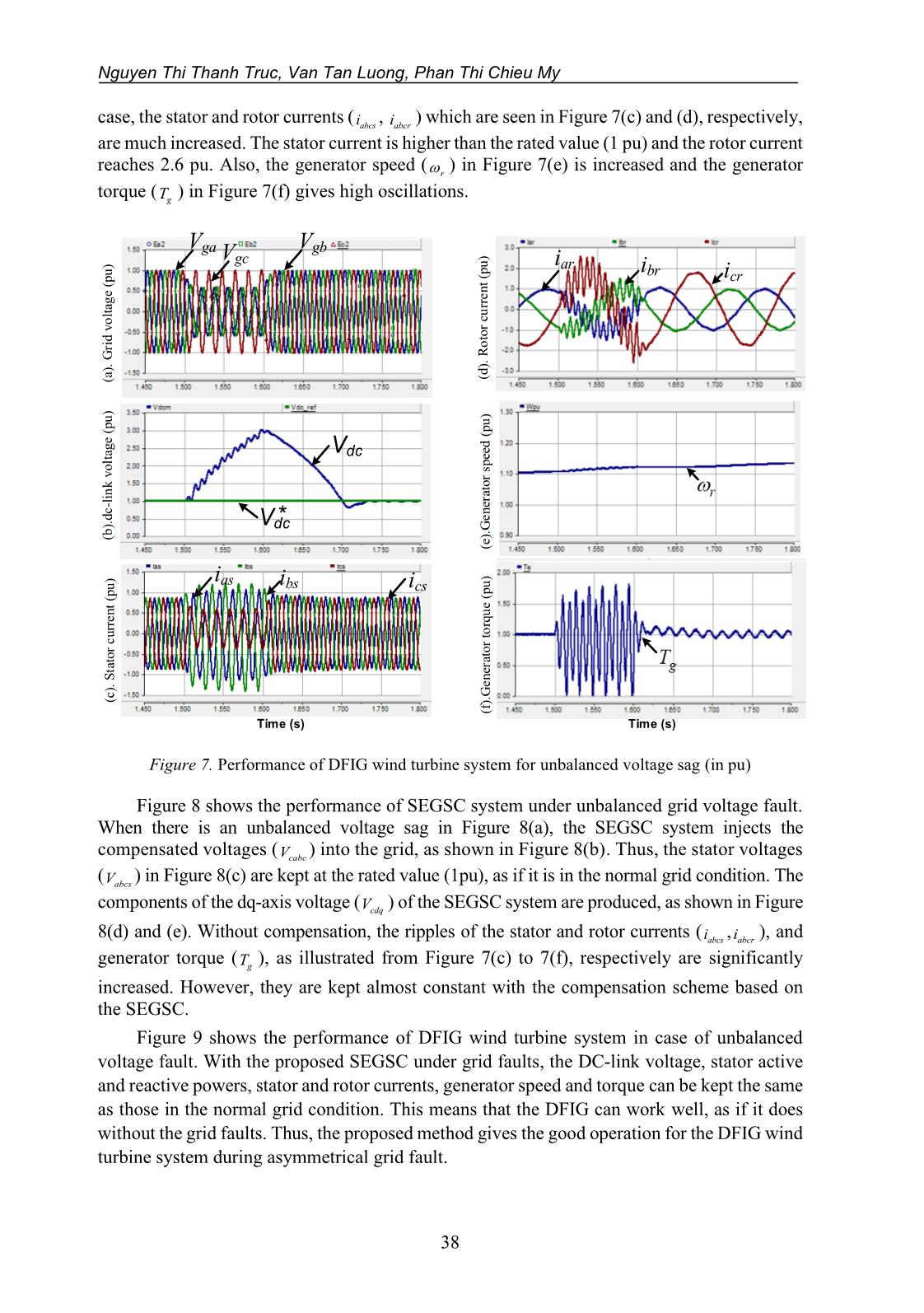
Trang 8
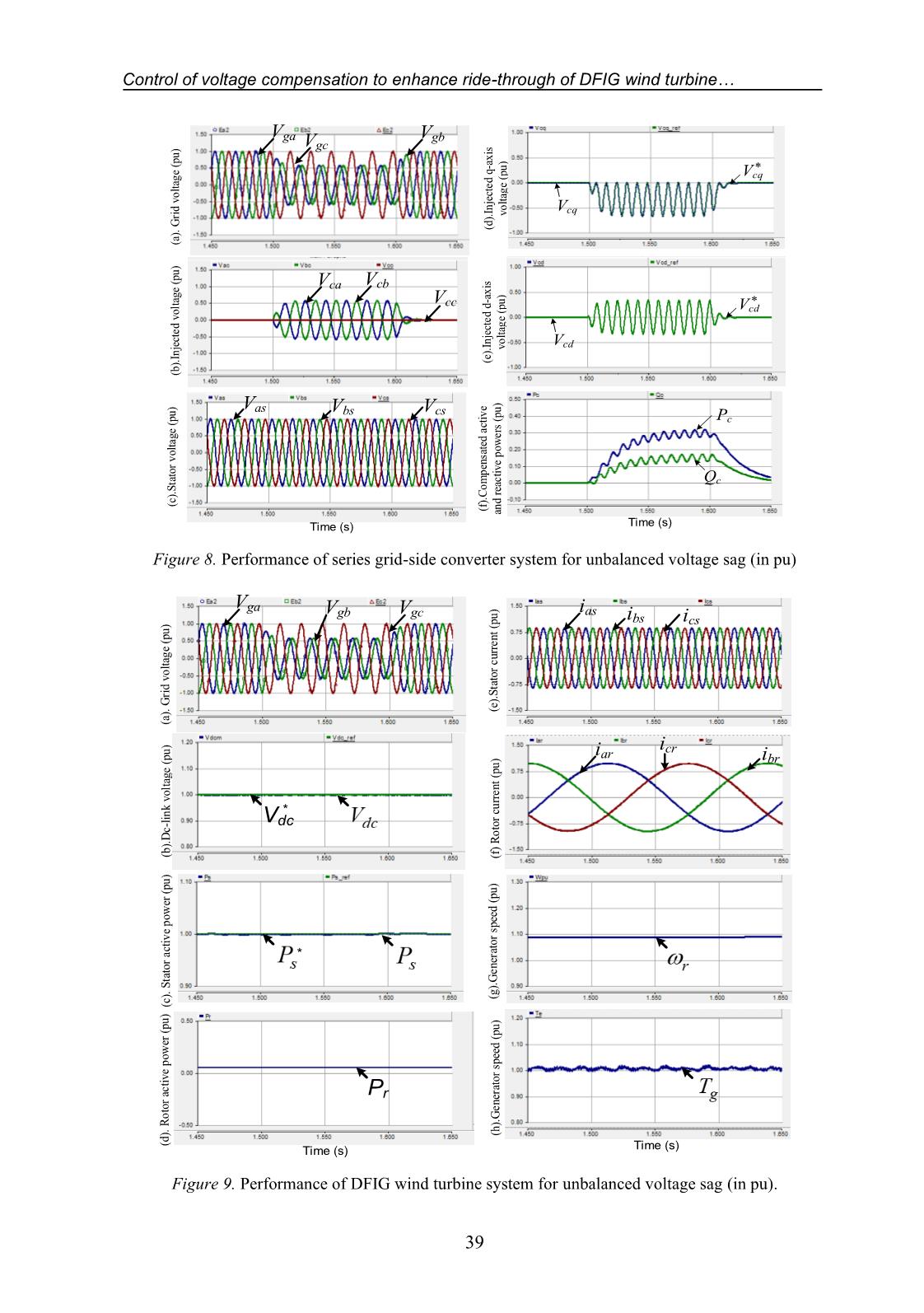
Trang 9
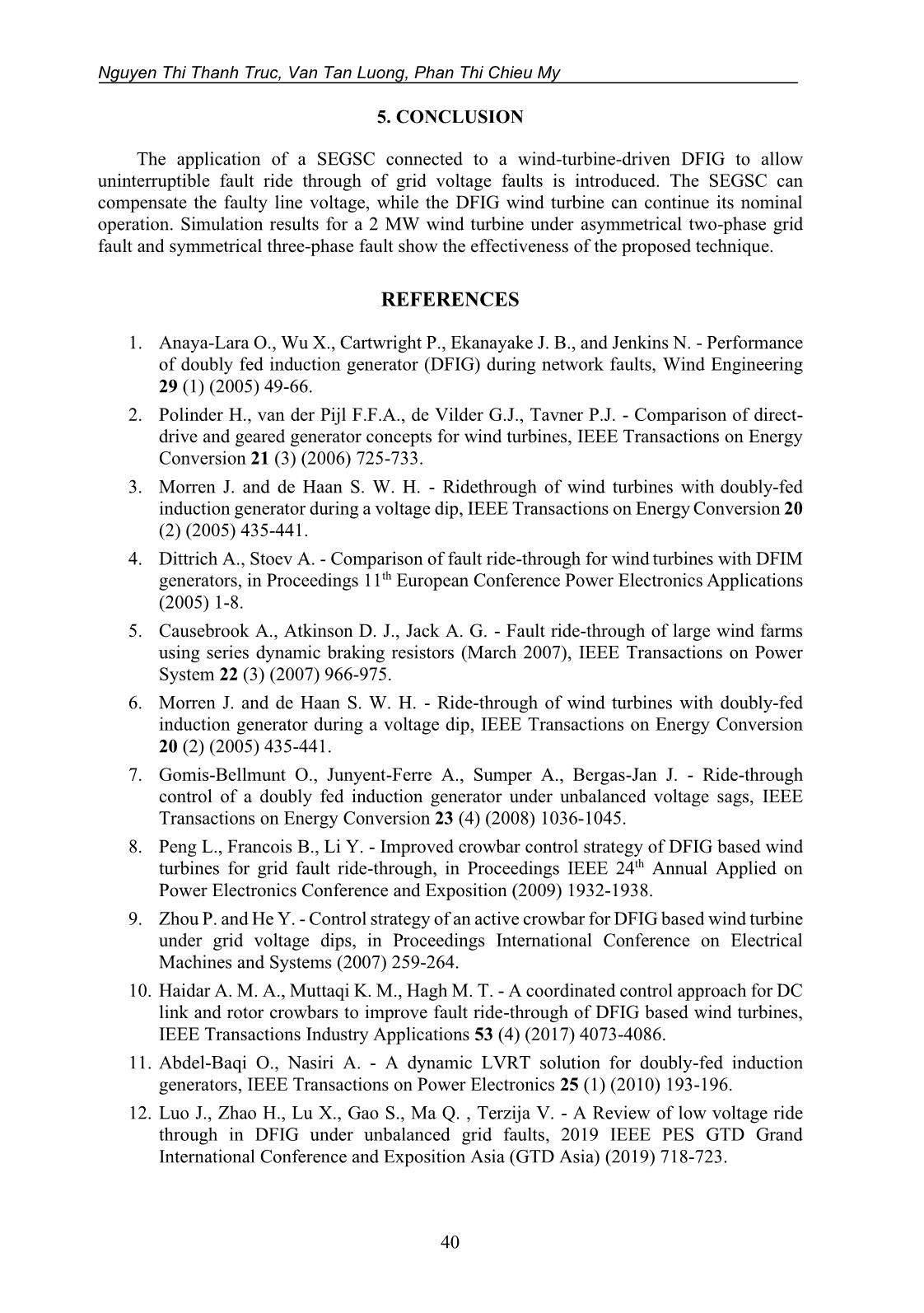
Trang 10
Tải về để xem bản đầy đủ
Tóm tắt nội dung tài liệu: Control of voltage compensation to enhance ride - Through of dfig wind turbine during symmetrical and asymmetrical grid faults
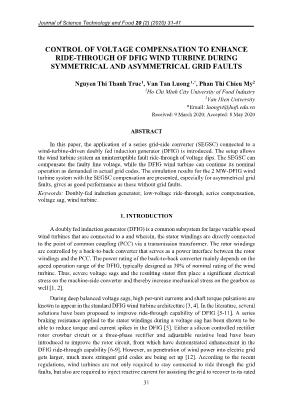
and series grid-side converter are listed in Table 1, 2 and 3, respectively. Control of voltage compensation to enhance ride-through of DFIG wind turbine 35 Table 1. Parameters of wind turbine Table 2. Parameters of 2 MW- DFIG Parameter Value Rated power 2 MW Grid voltage 690 V Stator voltage/frequency 690 V/60 Hz Stator resistance 0.00488 pu Rotor resistance 0.00549 pu Stator leakage inductance 0.0924 pu Rotor leakage inductance 0.0995 pu Generator inertia 200 kg.m2 Table 3. Parameters of SEGSC Parameter Value Capacity 0.8 MW DC-link capacitor 8200 F Inverter output filter L=0.1 mH, C =1000 F Switching frequency 2.5 kHz Series transformer 0.8 MW, 690 V/ 690 V 4.1. Symmetrical grid fault Figure 4 shows the system performance for balanced grid voltage fault (symmetrical grid fault) without using SEGSC system, where the wind speed is assumed to be constant (16.5 m/s) for easy investigation. The fault condition is 50% sag in three phases for 0.1 s which is between 1.4 s and 1.5 s. When there is the grid balanced voltage sag ( gabcV ) as shown in Figure 4(a), the negative-sequence component of the grid voltage does not exist. As can be seen from Figure 4 (b), the DC-link voltage ( dcV ) of the DFIG converter without using SEGSC reaches 1.2 pu, which can damage the dc capacitor and the converter switches. Also, the stator and Parameter Value Rated power 2 MW Blade radius 45 m Air density 1.225 kg/m3 Max. power conv. coefficient 0.4 Cut-in speed 3 m/s Cut-out speed 25 m/s Rated wind speed 16.5 m/s Blade inertia 6.3x106 kg.m2 Nguyen Thi Thanh Truc, Van Tan Luong, Phan Thi Chieu My 36 rotor currents ( abcsi , abcri ), as illustrated in Figure 4(c) to 4(d), respectively, are increased. Especially, the rotor currents are twice higher than rated values (1pu). In this case, the generator speed ( r ) which are illustrated in Figure 4(e) accelerates to achieve the optimal value for tracking the maximum power point. Similarly, the generator torque ( gT ) in Figure 4(f) is also decreased under the grid voltage fault. (a ). G ri d v o lt ag e (p u ) (b ). d c- li n k v o lt ag e ( p u ) (f ). G e n er at o r to rq u e (p u ) (e ). G e n er at o r sp ee d ( p u ) (c ). S ta to r c u rr e n t (p u ) (d ). R o to r cu rr e n t (p u ) Time (s)Time (s) Vga Vdc Vdc* Vgb Vgc ias ibs ics iar ibr icr Figure 4. Performance of DFIG wind turbine system for balanced voltage sag (in pu). (a ). G ri d v o lt ag e (p u ) (c ). S ta to r v o lt a g e (p u ) (b ). In je ct e d v o lt ag e ( p u ) (f ). C o m p en sa te d a ct iv e an d r ea c ti v e p o w e rs ( p u ) Time (s) (d ). In je ct e d q -a x is v o lt ag e (p u ) Time (s) Pc Qc Vcq *Vcq (e ). In je ct e d d -a x is v o lt ag e (p u ) Vcd *Vcd Vga Vgb Vgc Vca Vcb Vcc Vas Vbs Vcs Figure 5. Performance of series grid-side converter system for balanced voltage sag (in pu). Figure 5 shows the performance of SEGSC system under balanced grid voltage fault. Due to balanced voltage sag, as shown in Figure 5(a), the compensation voltages ( cabcV ) in Figure 5(b) are injected by the SEGSC system. With the compensation, the stator voltages ( abcsV ) in Figure 5(c) compensated, are kept at the rated value. The dq-axis voltages ( cdqV ) of the SEGSC are seen Control of voltage compensation to enhance ride-through of DFIG wind turbine 37 from Figure 5(d) and (e), respectively. Aslo, the active and reactive powers ( cP , cQ ) injected by the SEGSC are shown in Figure 5(f). Without SEGSC for voltage compensation, the stator and rotor currents, and torque give high ripples, as illustrated in Figure 4(c), 4(d) and 4(f), respectively. However, they are kept almost constant with compensation. Figure 6 shows the performance of DFIG wind turbine system in case of unbalanced voltage fault. It is obvious from Figure 6 that all quantities of the DFIG with the proposed SEGSC such as DC-link voltage, stator active and reactive powers, stator and rotor currents, generator speed and torque at grid faults have the same waveforms as those without grid faults. On the other hands, the DFIG still operates normally even though the grid fault occur. Thus, the proposed method obtains the good operation for the DFIG wind turbine system during symmetrical grid fault. (c ). S ta to r a ct iv e p o w er ( p u ) (b ). D c -l in k v o lt ag e ( p u ) (g ). G e n er at o r sp ee d ( p u ) Time (s)(d ). R o to r ac ti v e p o w er ( p u ) Time (s) (e ). S ta to r c u rr e n t (p u ) (h ). G e n er at o r sp ee d ( p u ) (f ) R o to r cu rr e n t (p u ) (a ). G ri d v o lt ag e (p u ) Vdc * * Pr Vga Vgb Vgc iar ibr icr ias ibs ics Figure 6. Performance of DFIG wind turbine system for balanced voltage sag (in pu). 4.2. Asymmetrical grid fault Figure 7 shows the system performance for unbalanced grid voltage fault (asymmetrical grid fault) without using SEGSC system. The fault condition is 40% sag in both the grid A-phase and C-phase voltages for 0.1 s which is between 1.4 s and 1.5 s. Since the fault type is an unbalanced one, the negative-sequence components in dq-axis of the grid voltage appear. Due to the grid unbalanced voltage sag ( gabcV ) as illustrated in Figure 7(a), the DC-link voltage ( dcV ) (see Figure 7 (b)) of the DFIG converter without compensation reaches 3 pu, which is high enough to deteriorate the dc capacitor as well as the switches of the converter. In this Nguyen Thi Thanh Truc, Van Tan Luong, Phan Thi Chieu My 38 case, the stator and rotor currents ( abcsi , abcri ) which are seen in Figure 7(c) and (d), respectively, are much increased. The stator current is higher than the rated value (1 pu) and the rotor current reaches 2.6 pu. Also, the generator speed ( r ) in Figure 7(e) is increased and the generator torque ( gT ) in Figure 7(f) gives high oscillations. (a ). G ri d v o lt ag e (p u ) (b ). d c -l in k v o lt ag e ( p u ) (f ). G e n er at o r to rq u e (p u ) (e ). G e n er at o r sp ee d ( p u ) (c ). S ta to r c u rr e n t (p u ) (d ). R o to r cu rr e n t (p u ) Time (s)Time (s) Vdc Vdc* Vga VgbVgc ias ibs ics iar ibr icr Figure 7. Performance of DFIG wind turbine system for unbalanced voltage sag (in pu) Figure 8 shows the performance of SEGSC system under unbalanced grid voltage fault. When there is an unbalanced voltage sag in Figure 8(a), the SEGSC system injects the compensated voltages ( cabcV ) into the grid, as shown in Figure 8(b). Thus, the stator voltages ( abcsV ) in Figure 8(c) are kept at the rated value (1pu), as if it is in the normal grid condition. The components of the dq-axis voltage ( cdqV ) of the SEGSC system are produced, as shown in Figure 8(d) and (e). Without compensation, the ripples of the stator and rotor currents ( abcsi , abcri ), and generator torque ( gT ), as illustrated from Figure 7(c) to 7(f), respectively are significantly increased. However, they are kept almost constant with the compensation scheme based on the SEGSC. Figure 9 shows the performance of DFIG wind turbine system in case of unbalanced voltage fault. With the proposed SEGSC under grid faults, the DC-link voltage, stator active and reactive powers, stator and rotor currents, generator speed and torque can be kept the same as those in the normal grid condition. This means that the DFIG can work well, as if it does without the grid faults. Thus, the proposed method gives the good operation for the DFIG wind turbine system during asymmetrical grid fault. Control of voltage compensation to enhance ride-through of DFIG wind turbine 39 (a ). G ri d vo lt ag e (p u ) (c ). S ta to r v ol ta ge ( pu ) (b ). In je ct ed v ol ta ge ( pu ) (f ). C o m p en sa te d a ct iv e an d re ac ti ve p ow er s (p u ) (e ). In je ct ed d -a x is vo lt ag e (p u ) Time (s)Time (s) (d ). In je ct ed q -a x is vo lt ag e (p u ) Vcq *Vcq Vcd *Vcd Pc Qc Vga VgbVgc Vca Vcb Vcc Vas Vbs Vcs Figure 8. Performance of series grid-side converter system for unbalanced voltage sag (in pu) (c ). S ta to r ac ti v e p ow er ( pu ) (b ). D c- li n k vo lt ag e (p u ) (g ). G en er at or s pe ed ( pu ) Time (s)( d ). R o to r ac ti ve p ow er ( pu ) Time (s) (e ). S ta to r cu rr en t (p u ) (h ). G en er at or s pe ed ( pu ) (f ) R o to r cu rr en t (p u ) (a ). G ri d vo lt ag e (p u ) Pr Vdc * * iar ibr icr ias ibs ics Vga Vgb Vgc Figure 9. Performance of DFIG wind turbine system for unbalanced voltage sag (in pu). Nguyen Thi Thanh Truc, Van Tan Luong, Phan Thi Chieu My 40 5. CONCLUSION The application of a SEGSC connected to a wind-turbine-driven DFIG to allow uninterruptible fault ride through of grid voltage faults is introduced. The SEGSC can compensate the faulty line voltage, while the DFIG wind turbine can continue its nominal operation. Simulation results for a 2 MW wind turbine under asymmetrical two-phase grid fault and symmetrical three-phase fault show the effectiveness of the proposed technique. REFERENCES 1. Anaya-Lara O., Wu X., Cartwright P., Ekanayake J. B., and Jenkins N. - Performance of doubly fed induction generator (DFIG) during network faults, Wind Engineering 29 (1) (2005) 49-66. 2. Polinder H., van der Pijl F.F.A., de Vilder G.J., Tavner P.J. - Comparison of direct- drive and geared generator concepts for wind turbines, IEEE Transactions on Energy Conversion 21 (3) (2006) 725-733. 3. Morren J. and de Haan S. W. H. - Ridethrough of wind turbines with doubly-fed induction generator during a voltage dip, IEEE Transactions on Energy Conversion 20 (2) (2005) 435-441. 4. Dittrich A., Stoev A. - Comparison of fault ride-through for wind turbines with DFIM generators, in Proceedings 11th European Conference Power Electronics Applications (2005) 1-8. 5. Causebrook A., Atkinson D. J., Jack A. G. - Fault ride-through of large wind farms using series dynamic braking resistors (March 2007), IEEE Transactions on Power System 22 (3) (2007) 966-975. 6. Morren J. and de Haan S. W. H. - Ride-through of wind turbines with doubly-fed induction generator during a voltage dip, IEEE Transactions on Energy Conversion 20 (2) (2005) 435-441. 7. Gomis-Bellmunt O., Junyent-Ferre A., Sumper A., Bergas-Jan J. - Ride-through control of a doubly fed induction generator under unbalanced voltage sags, IEEE Transactions on Energy Conversion 23 (4) (2008) 1036-1045. 8. Peng L., Francois B., Li Y. - Improved crowbar control strategy of DFIG based wind turbines for grid fault ride-through, in Proceedings IEEE 24th Annual Applied on Power Electronics Conference and Exposition (2009) 1932-1938. 9. Zhou P. and He Y. - Control strategy of an active crowbar for DFIG based wind turbine under grid voltage dips, in Proceedings International Conference on Electrical Machines and Systems (2007) 259-264. 10. Haidar A. M. A., Muttaqi K. M., Hagh M. T. - A coordinated control approach for DC link and rotor crowbars to improve fault ride-through of DFIG based wind turbines, IEEE Transactions Industry Applications 53 (4) (2017) 4073-4086. 11. Abdel-Baqi O., Nasiri A. - A dynamic LVRT solution for doubly-fed induction generators, IEEE Transactions on Power Electronics 25 (1) (2010) 193-196. 12. Luo J., Zhao H., Lu X., Gao S., Ma Q. , Terzija V. - A Review of low voltage ride through in DFIG under unbalanced grid faults, 2019 IEEE PES GTD Grand International Conference and Exposition Asia (GTD Asia) (2019) 718-723. Control of voltage compensation to enhance ride-through of DFIG wind turbine 41 13. Nguyen T. H., Lee D. C., Van T. L., Kang J.-H. - Coordinated control of reactive power between STATCOMs and wind farms for PCC voltage regulation, Journal of Power Electronics 13 (5) (2013) 909-918. 14. Van T. L. and Ho V. C. - Enhanced fault ride-through capability of DFIG wind turbine systems considering grid-side converter as STATCOM, Lecture Notes in Electrical engineering 371 (2015) 185-196. 15. Ibrahim A.O., Nguyen T. H., Lee D.-C., Kim S.-C. - A fault ridethrough technique of DFIG wind turbine systems using dynamic voltage restorers, IEEE Transactions on Energy Conversion 26 (3) (2011) 871-882. 16. Van T. L., Nguyen N. M. D., Toi L. T., Trang T. T. - Advanced control strategy of dynamic voltage restorers for distribution system using sliding mode control input- ouput feedback linearization, Lecture Notes in Electrical Engineering 465 (2017) 521-531. 17. Awad H., Svensson J., Bollen M. - Mitigation of unbalanced voltage dips using static series compensator, IEEE Transactions on Power Electronics 19 (3) (2004) 837-846. 18. Kim M.-B., Moon G.-W., Youn M.-J. - Synchronous PI decoupling control scheme for dynamic voltage restorer against a voltage sag in the power system, Proceedings of Annual IEEE Conference on Power Electronics Specialists 2 (2004) 1046–1051. 19. Kim J.-S. and Sul S.-K. - A novel voltage modulation technique of the space vector PWM, T. IEE Japan 116-D (8) (1996) 820-825. TÓM TẮT ĐIỀU KHIỂN BỒI HOÀN ĐIỆN ÁP ĐỂ CẢI THIỆN KHẢ NĂNG LƯỚT QUA ĐIỆN ÁP THẤP CỦA TUA-BIN GIÓ DÙNG MÁY PHÁT DFIG TRONG TRƯỜNG HỢP SỰ CỐ LƯỚI ĐỐI XỨNG VÀ BẤT ĐỐI XỨNG Nguyễn Thị Thanh Trúc1, Văn Tấn Lượng1,*, Phan Thị Chiêu Mỹ2 1Trường Đại học Công nghiệp Thực phẩm TP.HCM 2Trường Đại học Văn Hiến *Email: luongvt@hufi.edu.vn Bài báo giới thiệu việc áp dụng bộ biến đổi nối tiếp phía lưới (SEGSC) được kết nối với tua-bin gió dùng máy phát không đồng bộ nguồn kép (DFIG). Việc thiết lập mô hình này cho phép hệ thống tua-bin gió lướt qua sự cố lưới khi có sụt áp sâu. SEGSC có thể bồi hoàn điện áp của đường dây sự cố, trong khi tua-bin gió dùng máy phát DFIG có thể tiếp tục hoạt động bình thường theo quy luật làm việc của lưới thực tế. Các kết quả mô phỏng đối với hệ thống tua-bin gió 2 MW-DFIG có sử dụng bộ bù SEGSC cho kết quả vận hành tốt như trường hợp không có sự cố, đặc biệt đối với sự cố lưới không đối xứng. Từ khóa: Máy phát không đồng bộ nguồn kép, lướt qua điện áp thấp, bồi hoàn nối tiếp, độ võng điện áp lưới, tua-bin gió.
File đính kèm:
 control_of_voltage_compensation_to_enhance_ride_through_of_d.pdf
control_of_voltage_compensation_to_enhance_ride_through_of_d.pdf

